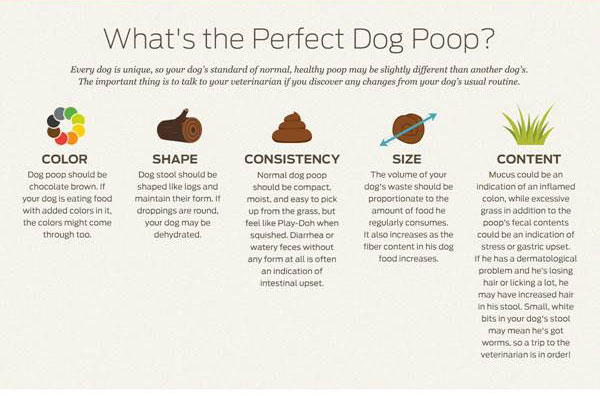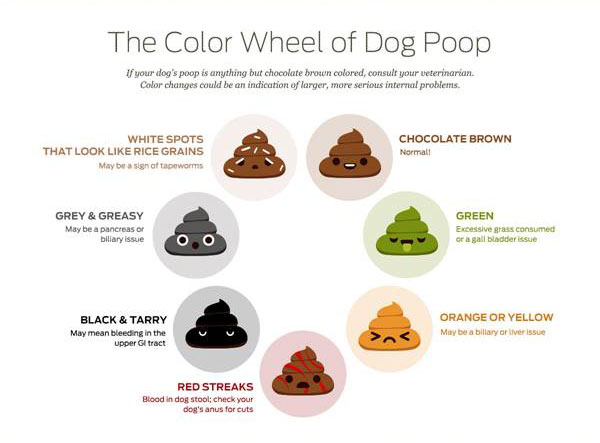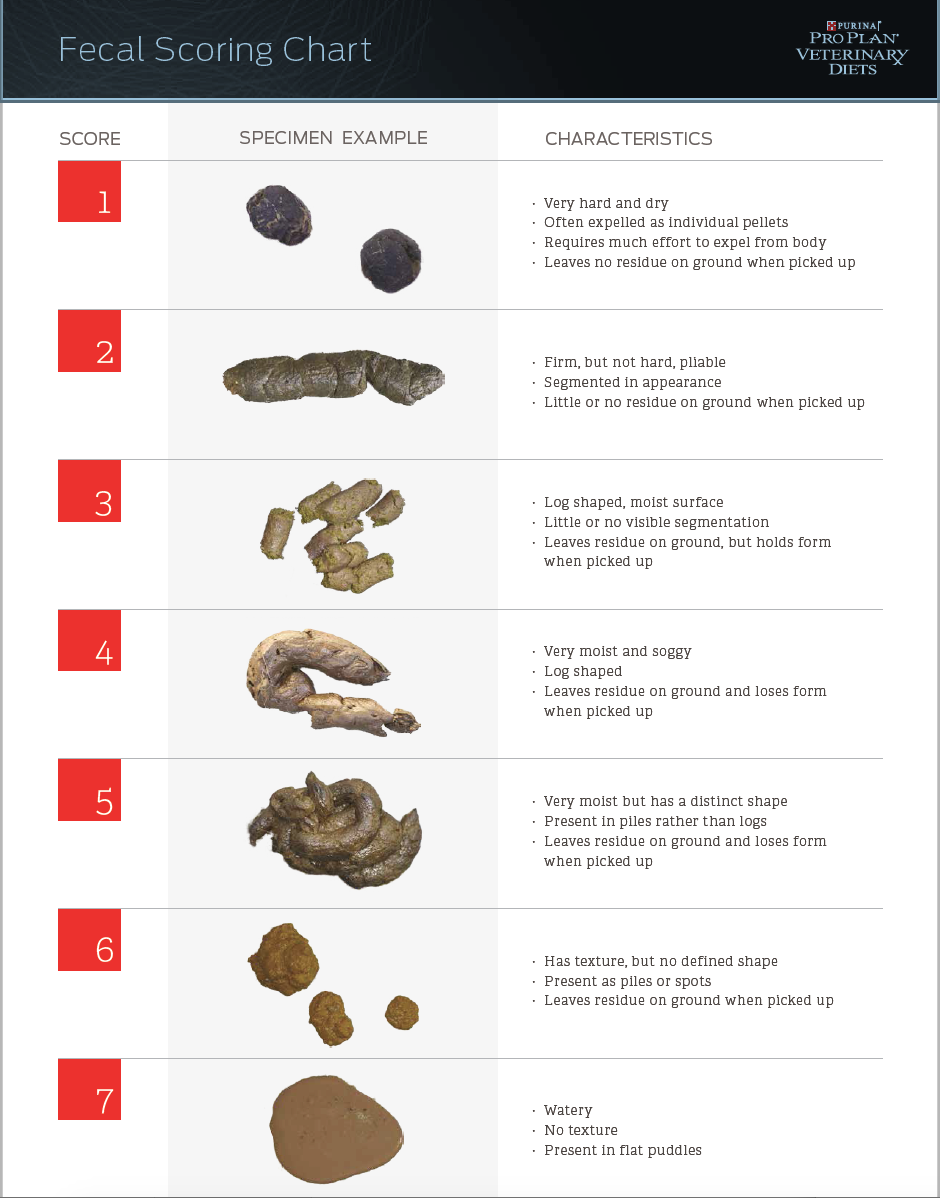What Poop Says About Your Dog’s Health
The consistency and color of diarrhea reveal a lot about the cause of the problem and what is happening in your dog. Take very careful note of the color, consistency, and anything else that might help when you describe the symptoms to a vet. In many cases, diarrhea will resolve after a few days of home treatment, but it’s a good idea to give your vet a call if it continues for a long period or has any one of several signs that may point to a serious problem.
This infographic from Purina gives you an idea of a “perfect dog poop,” which is chocolate brown, shaped like logs, compact, and easy to scoop. Experts say it should feel like cookie dough or Play-Doh when pressed. Large volumes, pudding-like or watery consistency, or signs of mucus (looks like jelly), or blood streaks, are not normal.

Take Note of the Color of the Poop
Color can also indicate a lot about what is going on inside your dog’s gut. Chocolate brown is normal, while colors like orange, green, or gray may signify issues with such organs as liver, gall bladder, or pancreas. Black tarry stool is very serious, and may point to internal bleeding. If you see this, contact your vet as soon as possible.
Purina has also provided a handy reference—a color wheel of dog poop.

Color, shape, and consistency will all help you and your vet figure out what is wrong when your dog gets diarrhea. These factors will help your vet determine where the problem is originating along the dog’s digestive tract.
Other Ways to Decipher Dog Poop
Following are some common abnormalities, in addition to color, and what each might be telling you about why your dog has the runs:
- Small amounts with straining, several times in an hour, which some people call “the squirts,” can be a sign of inflammation of the large bowel.
- Three or four times, with large volume, suggest small bowel disorder.

As disgusting as it may seem, it’s important that you examine your dog’s poop carefully if she has diarrhea so you can give your vet as many details as possible. Armed with this knowledge, the vet will be able to tell you whether to schedule and exam or whether you can treat it at home.
A great many cases are mild and, with your vet’s advice, maybe treated without a trip to the office. They may respond to a regimen of very basic treatments, including:
Over-the-Counter Dog Diarrhea Treatments
These over-the-counter dog diarrhea treatments are good to have on hand, and can be ordered online for quick delivery for those occasional bouts of loose stools or diarrhea that every dog can experience.
Fasting
Withholding food for 12 to 24 hours, and providing water in small amounts frequently, can clear the cause of the upset and allow the gastrointestinal tract to settle. It’s usually the first line of attack for diarrhea. Before you decide on a fast, be sure that your dog is healthy enough to endure it. Puppies, and elderly dogs, for example, need nutrients. Also, a fast may not be appropriate for small dogs who do not have the physical reserves of their larger cousins.
Diarrhea can lead to dehydration, so make sure to give your dog access to water at all times. You may also offer unflavored Pedialyte to help maintain electrolyte balance under a vet’s advice.
Kitchen Cures for Dog Diarrhea
After a fast, simple foods are usually introduced slowly. Many dog owners start with foods that act as binders, which can help normalize stool consistency. Some tried-and-true methods include:
Methods that work for one dog may not help another, so you might need to do a little experimentation to find the right formula. It might also be helpful to write down what works and what doesn’t so you’ll know what to do the next time you find yourself mopping up a mess.
Once you find a recovery diet that agree with your dog, and doesn’t cause a relapse, you can slowly increase the portions over a period of days, and then start to add small quantities of your dog’s regular food, until things are back to normal.
Clubs Offering:
AKC is a participant in affiliate advertising programs designed to provide a means for sites to earn advertising fees by advertising and linking to akc.org. If you purchase a product through this article, we may receive a portion of the sale.
It’s not a topic anyone likes to discuss, but if you own a dog, chances are you have found yourself cleaning up a stinky brown puddle (or, not-quite-politely put, doggie “runs”) more than you’d care to think about.
Diarrhea is a common canine affliction and it varies in frequency, duration, and intensity from dog to dog.
You may not be able to totally prevent diarrhea, but knowing as much as possible about it might help limit the number times your dog has one of these unpleasant episodes and reduce the duration when the runs do come. Luckily, there are even a number of over-the-counter diarrhea treatments for dogs.
There are significant differences between the way dogs and people digest food.
Human jaw shape and salivary enzymes, for example, will start breaking down a morsel in the mouth. Dogs, on the other hand, have mouths and jaws made for tearing, crushing, and wolfing food down. Their salivary enzymes are mostly designed to kill bacteria, which is why they can tolerate items that would send their human companions to the hospital.
Food travels rapidly down the canine esophagus and enters the stomach in chunks, where most digestion takes place. Canine stomach acids are about three times stronger than those of humans, so they can digest food that is pretty much intact. Under normal circumstances, transit time from mouth through the small and large intestines should be under 10 hours, producing a firm, well-formed stool at the end.
Many things can disrupt this well-balanced system, causing diarrhea or, less frequently, constipation. Some things, like eating too much grass, are not serious at all. Others can be a sign of a life-threatening problem, such as an indigestible object (like a rock) lodged in the stomach, or a disease like cancer.
There are many reasons why a dog may develop loose stools, but most cases may be attributed to one of these 12 triggers:
- Roundworms
- Hookworms
- Whipworms
- Coccidia
- Giardia
- Parvovirus
- Distemper
- Canine coronavirus
Other Causes of Diarrhea in Dogs
While rarer, your dog’s diarrhea could also be caused by one of these conditions:
Dog Runny Poop (Oh no! My Dog Has Soft Poop)
Few symptoms are more concerning (and perhaps messy!) for pet parents than when their dog has diarrhea. Our Baltimore vets understand that if your pup has diarrhea, you need a cure quickly. Here are some of the most common causes of diarrhea in dogs and what you can do to help resolve the distressing issue.
Many dogs will have issues with diarrhea in their lifetimes, for a wide range of reasons.
Mild bouts of diarrhea are common in our canine friends and can be caused by mild intestinal distress, often because your dog has eaten a small amount of something that doesnt agree with them, such as scraps from the dinner table, or just as a result of switching to a new flavor or brand of food.
That said, many serious health issues can cause your dog to suffer from diarrhea. Today, our Baltimore vets will list these issues, recommend when to contact your vet and describe common treatments.
With all these potential causes, how do you know whether your dog will need to visit the vet?